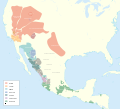Comanche: Difference between revisions
CSV import Tags: mobile edit mobile web edit |
CSV import |
||
| (One intermediate revision by the same user not shown) | |||
| Line 1: | Line 1: | ||
== | {{Infobox ethnic group | ||
| group = Comanche | |||
| image = | |||
| caption = | |||
| population = | |||
| region1 = | |||
| languages = [[Comanche language|Comanche]], [[English language|English]] | |||
| religions = [[Native American religion|Native American religion]], [[Christianity]] | |||
| related = [[Ute people|Ute]], [[Shoshone people|Shoshone]] | |||
}} | |||
The '''Comanche''' are a Native American tribe from the Great Plains whose historic territory consisted of present-day eastern New Mexico, southeastern Colorado, southwestern Kansas, western Oklahoma, and most of northwest Texas. They are federally recognized as the [[Comanche Nation]], headquartered in [[Lawton, Oklahoma]]. | |||
== | ==History== | ||
The Comanche were | The Comanche were originally part of the [[Eastern Shoshone]] who lived near the upper reaches of the [[Platte River]] in eastern [[Wyoming]]. They migrated south in the early 18th century, where they became known as the Comanche. Their migration was facilitated by their acquisition of horses, which allowed them to become highly skilled horsemen and formidable warriors. | ||
==Culture== | ==Culture== | ||
The Comanche were known for their [[nomadic]] lifestyle, relying heavily on the [[American bison|bison]] for food, clothing, and shelter. They lived in [[tipis]], which were well-suited for their mobile lifestyle. The Comanche were also skilled traders, exchanging goods with other tribes and European settlers. | |||
==Language== | |||
The Comanche language | The Comanche language is a member of the [[Uto-Aztecan languages|Uto-Aztecan language family]]. It is closely related to the [[Shoshone language]]. Efforts are being made to preserve and revitalize the language among the Comanche people today. | ||
==Modern Day== | ==Modern Day== | ||
Today, the Comanche Nation is federally recognized | Today, the Comanche Nation is a federally recognized tribe with a population of approximately 17,000 members. The tribe operates its own government and provides various services to its members, including health care, education, and housing. | ||
==See also== | |||
* [[Native American tribes in Oklahoma]] | |||
* [[Plains Indians]] | |||
* [[History of Texas]] | |||
==References== | |||
* [[American Indian Wars]] | |||
* [[Horse culture of the Great Plains]] | |||
{{Native American tribes}} | |||
{{Indigenous peoples of North America}} | |||
[[Category:Native American | [[Category:Comanche]] | ||
[[Category: | [[Category:Native American tribes in Oklahoma]] | ||
[[Category:Plains tribes]] | |||
[[Category:Indigenous peoples of the Great Plains]] | |||
<gallery> | |||
File:LaDonnaHarris.png|LaDonna Harris | |||
File:Uto-Aztecan map.svg|Uto-Aztecan map | |||
File:War on the Plains Comanche vs Osage by George Catlin 1834.png|War on the Plains Comanche vs Osage by George Catlin 1834 | |||
File:DodgeComancheEmissary.png|Dodge Comanche Emissary | |||
File:Comancheria.png|Comancheria | |||
File:Comanche Lookout Arthur T. Lee.jpg|Comanche Lookout Arthur T. Lee | |||
File:Comanchebraves.jpg|Comanche braves | |||
File:Chief Quanah Parker of the Kwahadi Comanche.jpg|Chief Quanah Parker of the Kwahadi Comanche | |||
File:Mac silverhorn drumming.jpg|Mac silverhorn drumming | |||
File:Edward S. Curtis Collection People 085.jpg|Edward S. Curtis Collection People 085 | |||
</gallery> | |||
Latest revision as of 05:45, 3 March 2025
The Comanche are a Native American tribe from the Great Plains whose historic territory consisted of present-day eastern New Mexico, southeastern Colorado, southwestern Kansas, western Oklahoma, and most of northwest Texas. They are federally recognized as the Comanche Nation, headquartered in Lawton, Oklahoma.
History[edit]
The Comanche were originally part of the Eastern Shoshone who lived near the upper reaches of the Platte River in eastern Wyoming. They migrated south in the early 18th century, where they became known as the Comanche. Their migration was facilitated by their acquisition of horses, which allowed them to become highly skilled horsemen and formidable warriors.
Culture[edit]
The Comanche were known for their nomadic lifestyle, relying heavily on the bison for food, clothing, and shelter. They lived in tipis, which were well-suited for their mobile lifestyle. The Comanche were also skilled traders, exchanging goods with other tribes and European settlers.
Language[edit]
The Comanche language is a member of the Uto-Aztecan language family. It is closely related to the Shoshone language. Efforts are being made to preserve and revitalize the language among the Comanche people today.
Modern Day[edit]
Today, the Comanche Nation is a federally recognized tribe with a population of approximately 17,000 members. The tribe operates its own government and provides various services to its members, including health care, education, and housing.
See also[edit]
References[edit]
Template:Native American tribes
| Indigenous peoples of North America |
|---|
|
This Indigenous peoples of North America related article is a stub.
|
-
LaDonna Harris
-
Uto-Aztecan map
-
War on the Plains Comanche vs Osage by George Catlin 1834
-
Dodge Comanche Emissary
-
Comancheria
-
Comanche Lookout Arthur T. Lee
-
Comanche braves
-
Chief Quanah Parker of the Kwahadi Comanche
-
Mac silverhorn drumming
-
Edward S. Curtis Collection People 085









